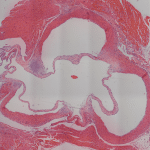It's Not Just Calcium
It’s not just calcium that calcifies the valve.a
Calcific aortic valve disease affects the valve leaflets of the aortic valve, which is the valve between the left ventricle- the main pumping chamber of the heart, and the aorta, which carries the oxygenated blood to the body. The valve becomes heavily calcified with progressive narrowing of the opening, until the heart struggles to eject sufficient blood to meet the needs of the body. This process is the most common reason for valve replacement in the US and Europe. Despite the advances in our understanding of molecular biology, the cellular mechanisms involved in the development of calcific aortic disease are poorly understood. We do know that this is an active process that involves inflammation and the transformation of aortic valve cells into bone-producing cells known as osteoblasts.a
Chronic kidney disease is a significant risk factor for calcific aortic valve disease. Up to 40% of patients who suffer from end-stage renal disease develop extensive calcification, likely due to abnormalities of mineral metabolism and hormonal changes that promote the calcific process and accelerate the progression. High levels of phosphate in the blood may play an important role in the process. Animal studies of end-stage kidney disease have found that when there are high levels of phosphate in the circulation, calcific regions begin to appear on the walls of arteries. Several animal studies including studies performed in our laboratory have reported significant calcium deposition occurring within the aorta and the aortic valve that were amplified when a phosphate-enriched diet was used and minimized when a low phosphate diet was given to the animals. Unfortunately, clinical trials in dialysis patients using phosphate binders did not lead to improved heart outcomes. This led to the question as to what is the role of phosphate in valvular calcification. Understanding of this may help us develop medications that will prevent this valvular disease.a
We explored this in rats in our laboratory, whom we fed a high phosphate diet at different times in their development. This study, recently published in the American Journal of Physiology, Heart and Circulatory Physiology section, found that phosphate is essential for the initiation of the process. In this phase, inflammatory cells accumulate within the aortic valve, and the cells begin to resemble osteoblasts. Even before the calcification begins to occur, there is a “point of no return.” After that, calcification begins, and it no longer matters whether or not phosphate is present.a
Our findings emphasize the complexity of the calcification process and suggest that different mediators during different phases lead to calcification. We will continue to research this complicated field to determine when and how we can intervene to prevent this very common valve problem.a
חיפוש
פוסטים אחרונים
Inspirational advice for women about heart disease in honor of International Women's Day
Excerpts from Onlife Magazine March 8 2022 Heal...The Pollin Food Literacy Initiative: Innovative, Creative, Empowering
The Pollin Food Literacy initiative aims to imp...It's Not Just Calcium
It’s not just calcium that calcifies the valve....Waterpipe (Nargila) Smoking – Myth vs. Reality article and picture
They say that it’s a harmless hobby – les...Gender Equity in Medical Research article and picture
For years we have complained that there aren’t ...
